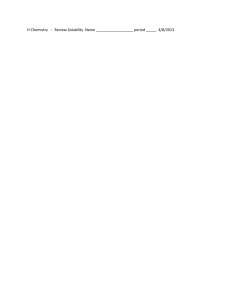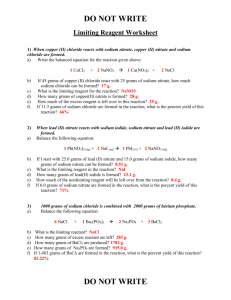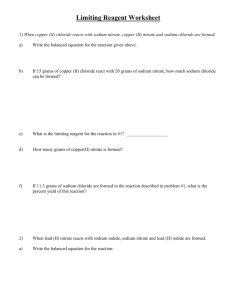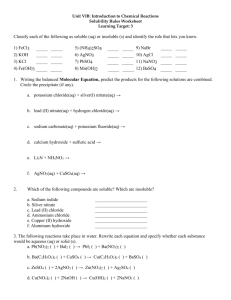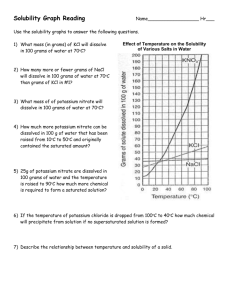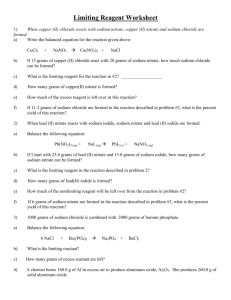Chemistry Review Solutions
advertisement
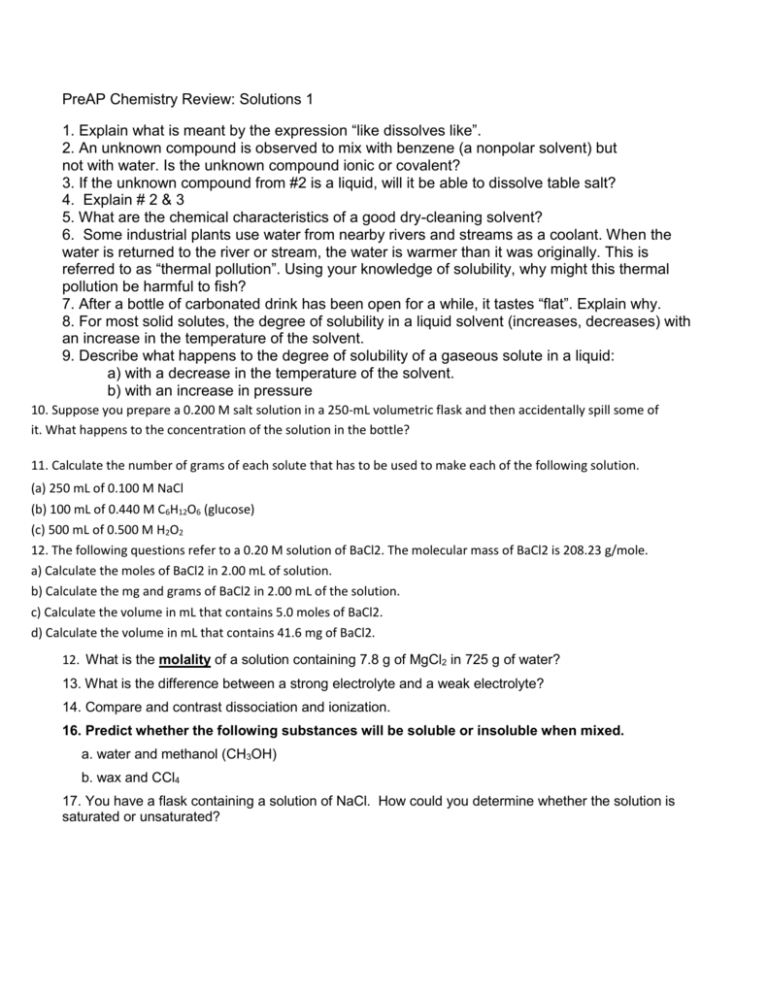
PreAP Chemistry Review: Solutions 1 1. Explain what is meant by the expression “like dissolves like”. 2. An unknown compound is observed to mix with benzene (a nonpolar solvent) but not with water. Is the unknown compound ionic or covalent? 3. If the unknown compound from #2 is a liquid, will it be able to dissolve table salt? 4. Explain # 2 & 3 5. What are the chemical characteristics of a good dry-cleaning solvent? 6. Some industrial plants use water from nearby rivers and streams as a coolant. When the water is returned to the river or stream, the water is warmer than it was originally. This is referred to as “thermal pollution”. Using your knowledge of solubility, why might this thermal pollution be harmful to fish? 7. After a bottle of carbonated drink has been open for a while, it tastes “flat”. Explain why. 8. For most solid solutes, the degree of solubility in a liquid solvent (increases, decreases) with an increase in the temperature of the solvent. 9. Describe what happens to the degree of solubility of a gaseous solute in a liquid: a) with a decrease in the temperature of the solvent. b) with an increase in pressure 10. Suppose you prepare a 0.200 M salt solution in a 250-mL volumetric flask and then accidentally spill some of it. What happens to the concentration of the solution in the bottle? 11. Calculate the number of grams of each solute that has to be used to make each of the following solution. (a) 250 mL of 0.100 M NaCl (b) 100 mL of 0.440 M C6H12O6 (glucose) (c) 500 mL of 0.500 M H2O2 12. The following questions refer to a 0.20 M solution of BaCl2. The molecular mass of BaCl2 is 208.23 g/mole. a) Calculate the moles of BaCl2 in 2.00 mL of solution. b) Calculate the mg and grams of BaCl2 in 2.00 mL of the solution. c) Calculate the volume in mL that contains 5.0 moles of BaCl2. d) Calculate the volume in mL that contains 41.6 mg of BaCl2. 12. What is the molality of a solution containing 7.8 g of MgCl2 in 725 g of water? 13. What is the difference between a strong electrolyte and a weak electrolyte? 14. Compare and contrast dissociation and ionization. 16. Predict whether the following substances will be soluble or insoluble when mixed. a. water and methanol (CH3OH) b. wax and CCl4 17. You have a flask containing a solution of NaCl. How could you determine whether the solution is saturated or unsaturated? Use the solubility curve to answer questions 18 – 20. 18. How many grams of potassium nitrate can dissolve in 100 g of water at 50C? 19. At 20C, a solution contains 120 g of NaNO3 in 100 g of water. Is this solution saturated, unsaturated, or supersaturated? 20. You need to make a solution containing 150 g of potassium chloride in 300 g of water. What temperature is required? 21. Fish “breathe” by absorbing oxygen gas that is dissolved in water. Thermal pollution is caused when the temperature of the water in lakes and streams increases due to warm water output from power plants. Explain why thermal pollution is harmful to the fish population. 22. Explain why a bottle of soda fizzes when you first open it. Balance these equations: 23. PCl5 + H2O H3PO4 + HCl 24. MgO + Si Mg + SiO2 25. CaCl2 + Na2CO3 CaCO3 + NaCl 26. Calcium phosphate reacts with sulfuric Acid (H2SO4) to give phosphoric acid (H3PO4) and calcium sulfate as a solid. Write the balanced equation for this reaction. Write the correct chemical formula for the following: 27. Magnesium Nitride 28. Iron (III) Oxide 29. A gas occupies 3.5L at 2.5 mm Hg pressure. What is the volume at 10 mm Hg at the same temperature? P1V1 = P2V2 30. How many moles of Al would be required to produce 18.0 mol of H2 ? Complete the equation 1st then balance it. __ HCl + __ Al → 31.When copper (II) chloride reacts with sodium nitrate, copper (II) nitrate and sodium chloride are formed. a) Write the balanced equation for the reaction given above: b) If 15 grams of copper (II) chloride react with 20 grams of sodium nitrate, how much sodium chloride can be formed? c) What is the limiting reagent for the reaction in #2? __________________ d) How much of the nonlimiting reagent is left over in this reaction?


